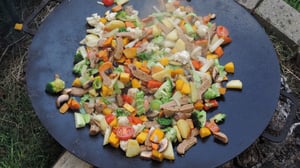This is part one of our three part blog series, exploring the options, benefits, risks and popularity of meat alternatives in Europe. Click here for part two!
What’s driving consumer demand for plant-based alternatives to meat?
The European market for meat alternatives is rapidly expanding, with the UK market alone reportedly worth £572m in 2017, a £33m increase from just two years earlier (http://bit.ly/2CKCrYN) and retail sales are predicted to continue growing to £658m by 2021.
 So why this dramatic increase in popularity?
So why this dramatic increase in popularity?
Meat alternative products are no longer solely targeted at the proportionately narrow consumer groups that identify as vegetarian, in which any foods that consist of, or have been produced with the aid of products consisting of any part of an animal are strictly avoided (The Vegetarian Society) or vegan, in which all products derived wholly or partly from animals are strictly avoided in the diet (The Vegan Society, 1994).
Instead, a distinct proportion of this growth in sales is being largely influenced by the popular ‘flexitarian’ movement, a term meaning ‘flexible vegetarian’, in which those seeking to reduce their meat consumption do so by substituting some, but not all, of the meat and dairy in their weekly diet for plant-based alternatives. Recent research had shown that as many as 22 million UK citizens now identify as being a ‘flexitarian’, viewed not as a fad diet, but instead a permanent lifestyle choice, notably most popular among highly influential millennials. Driving factors behind adopting a plant-based diet include concerns regarding animal welfare, personal health, environmental interests, budget restraints or simply disliking the taste of meat and/or fish.
In contrast to the diet of a vegan, it offers flexibility in terms of food choice, allowing those following this increasingly mainstream movement to eat entirely meat-free on a Saturday, but still wholeheartedly enjoy their roast beef the following Sunday. However, this is not a new phenomenon, with campaigns such as ‘Meat Free Monday’ actively promoting the idea of a flexitarian lifestyle since 2009, through raising awareness of the detrimental environmental impact of meat overconsumerism.
Alongside this movement, the number of people converting to veganism, still the leading consumers of meat alternative products, has increased by an estimated 360% over the last 10 years, meaning the demand for ethical, affordable and appetising meat alternatives is greater than ever. In response to these changing eating patterns and subsequent increasing consumer demand across Europe for alternative sources of protein on our shelves, companies are investing heavily in further promoting and driving development of new and enticing meat-free products in the vegetarian category.
What is a meat alternative?
A plant-based diet is focused around foods derived from plant sources, including fruit, vegetables, grains, pulses, seeds, legumes and nuts, but can still also contain small amounts of lean meats and reduced-fat dairy products. Meat alternatives, also known as meat analogues or substitutes, can be defined as vegetarian products which imitate the taste and texture properties of popular meat products, and are often a substantial component of the vegetarian/vegan diet.
As well as the growth in vegan, vegetarian and flexitarian consumer groups, the steady increase in the global population, urbanization, industrialization, and rise in income means demand for meat, like other commodities, is being stretched and is not sustainable long term and solutions are evidently needed (Alavi, 2014).
‘Synthetic’ meats are generally comprised of plant proteins in an adapted cooking extrusion process, formed into fibrous meat-like structures that comprise the basis for an array of meat-free consumer products (Pavan et al., 2017). Their primary aim is to replace the taste and textural function of meat in a dish whilst providing a similarly high protein nutritional value, which in turn offers a cost-effective, sustainable and generally healthier alternative to meat products.
The European food sector is quickly capitalising on this change in consumer interest by leading the way in meat-free innovation, accounting for almost 40% of global sales. In fact, 70% of market launches for new meat alternative products are European, with Germany topping the list (http://bit.ly/2oWA1fO). Not only are they popular among consumers, but also advantageous for the processing industry, as they are cost-effective to produce, can be stored easily and have a longer shelf-life than most other protein sources (Pavan et al., 2017).
The changing attitude to meat-free foods
Vegetarian food products of the past have often been considered to be lacking in 'charisma'; dull, beige and often bland products masquerading as ‘superior’ meat, which gave the consumer little to get excited about. But the meat-free lifestyle has gone through a rebranding, now undeniably possessing a cooler, trendier image, and in turn the meat-free products available in today’s European market are catching up.
 Social media provides a visual platform that enables users to share and promote vibrant and aesthetically appealing images of meat-free meals alongside conscious and health-affirming hashtags such as #veganfit and #consciouseating, which sell this ‘idealistic’ lifestyle to users across the globe. There is now a strong and established online vegan community who continue to influence others by promoting the numerous, yet sometimes controversial, benefits of reducing meat consumption.
Social media provides a visual platform that enables users to share and promote vibrant and aesthetically appealing images of meat-free meals alongside conscious and health-affirming hashtags such as #veganfit and #consciouseating, which sell this ‘idealistic’ lifestyle to users across the globe. There is now a strong and established online vegan community who continue to influence others by promoting the numerous, yet sometimes controversial, benefits of reducing meat consumption.
Moreover, advertisements in the media often depict well-known celebrities endorsing meat-free products, using their considerable influence to promote plant-based living to the impressionable public. Something that is certainly evident from social media is that there is a fresh sense of pride and community in following a plant-based diet.
In order to appeal more to the mass market, several food outlets have sprung up which offer consumers more decadent, often deep fried versions of their favourite meat substitutes, breaking down the predisposed concept that plant-based, vegan cuisine is generally a healthier and more virtuous option. This 'naughtier' approach to plant-based dining makes it an even easier transition from meat for those considering swapping to some alternative sources of protein, but still wanting to indulge in a less healthy meal from time to time.
What do consumers really want?
Before manufacturers start developing novel and exciting products for the meat-free market, they need to have a strong understanding of what the everyday consumer actually looks for in products used to mimic the meat component in their dishes.
Analysis recently undertaken by market research firm Mintel reveals that consumers of plant-based foods often pay attention to the product’s ingredients, scrutinising the labels for identifiable vegetable-based ingredients, which constitutes a substantial factor in their purchasing behavior. Because of this, the use of peas, lentils, legumes, nuts and pulses are often utilised advantageously by manufactures, as they are both recognisable to consumers, whilst generally being well regarded for their evidence-based health benefits.
The other top findings from this survey was the desire for convenience among consumers, as well as a preference for meat-free products that mimic the appearance of real meat products, such as burgers, sausages and bacon. It seems that choosing meat-substitutes that are shaped into familiar and easily identifiable formats, tends to be an easier transition for many into the world of meat-free cuisine.
‘None of my searches in the area of food science are complete without running them through FSTA.’ (Food Science Professor, Brigham Young University, USA)
Popular meat-substitutes
Here is a brief low-down on some of most popular meat alternatives available in the European market to date;
Texturized Vegetable Protein (TVP):
TVP, also referred to as textured soy protein, is made of soy flour that has been defatted, heated and pressurized until it forms small, absorbent sponge-like flakes or small chunks. TVP is commercially available in a dried form which requires reconstituting with water or stock to prepare, or a frozen form that requires defrosting before use.
When prepared they retain their structural integrity and characteristic ‘chewy’ texture, similar to that of meat. It is a high quality, complete source of protein for those restricting their meat consumption, containing all 9 essential amino acids, whilst also providing 15% of the recommended daily intake of iron via fortification, 0% fat content and only 80kcal per recommended portion. It is designed to have a neutral flavor which makes it highly flexible for use as a substitute for ground meat in dishes such as chilli and bolognese.
Trace amounts of hexane, a chemical by-product of petroleum refining, have been detected in products containing TVP after surviving the extrusion process during production. Despite the Environmental Protection Agency (EPA) recognising that long-term ingestion of high levels of hexane-contaminated foods can potentially increase the risk of neurological disease in humans, there are no requirements for food manufactures to test the level of hexane in consumer products, therefore those wanting to avoid consuming hexane should purchase organic TVP products.
Consumers should also be made aware that the salt content in TVP and most other meat substitutes is comparably greater than that of meat and poultry, therefore the importance of complementing meat analogues with other plant-based sources of protein such as seeds and pulses is stressed.
Tempeh:
Originating in Indonesia, tempeh is another soy-derived meat alternative, made instead by fermenting whole, partially cooked soybeans with Rhizopus oligosporus culture. It is available commercially in a slab or cake form, but is also sold in strips as a popular ‘fake’ bacon (often referred to as 'facon'): a meat product which many vegetarians and vegans feel nostalgic for. It has a dense, chewy texture with a nutty, slightly sour flavor, and can be used in a similar culinary context to tofu.
However, unlike tofu, it is superior in terms of its nutritional profile due largely to the fermentation process, which increases the bioavailability of certain minerals often lacking in a vegetarian and vegan diet. These include iron and zinc, important for oxygen transfer around the human body and maintaining a healthy immune system. It also provides 16g of complete protein and 7g of dietary fibre per average portion, and in contrast to most red meats, it contains very little saturated fat, making it an ideal recommendation for those trying to reduce their cholesterol as part of a heart-healthy diet.
Considerations should be made regarding the chosen cooking method, as stir-frying tempeh in oil had been shown to deplete its mineral content, whilst adding unnecessary calories (Setiawan et al., 2016). Therefore alternative methods, such as steaming, are a better option to ensure tempeh retains its optimal nutrient profile.
Tofu:  Tofu, also referred to as bean curd, is a popular soya-derived meat alternative and is a staple in Thai and Chinese cuisine. It is made in a similar way to that of cheese; fresh soya milk is curdled, the whey is discarded while the curds are pressed into a firm white block and then cooled. Like TVP, it possesses a neutral taste which can be easily enhanced by other ingredients and is commercially available in varying consistencies, from firm to silken, making it a flexible ingredient to introduce to most dishes.
Tofu, also referred to as bean curd, is a popular soya-derived meat alternative and is a staple in Thai and Chinese cuisine. It is made in a similar way to that of cheese; fresh soya milk is curdled, the whey is discarded while the curds are pressed into a firm white block and then cooled. Like TVP, it possesses a neutral taste which can be easily enhanced by other ingredients and is commercially available in varying consistencies, from firm to silken, making it a flexible ingredient to introduce to most dishes.
In terms of nutrition, tofu is a good source of complete protein, low in calories at about 70kcal per 100g and nutrient-dense, being an excellent source of iron and calcium and the minerals selenium, phosphorus and manganese.
A frequent topic of concern often raised by consumers in relation to soya based foods is the proposed association between soya intake and breast cancer risk, given that soya contains isoflavones; a class of phytoestrogen that is similar in structure to the female hormone oestrogen. It is true that high levels of oestrogen have been shown to encourage breast cancer growth, however reassuringly for consumers, research has proven that phytoestrogens, despite being structurally similar to oestrogen, do not have the same detrimental impact on the human body and are safe to consume within a balanced diet. Research even suggests that a moderate intake of soya-rich foods in women with a history of breast cancer can play a role in reducing the likelihood of cancer relapse; yet another reason why tofu, like other soya-based meat alternatives, can be viewed as a healthy, convenient and versatile plant-based option!
Seitan:
Gluten-based meat substitutes are an ever growing segment being explored in the European market (Anon., 2018), as they provide a bite, chew and mouthfeel very similar to that of real meat. Seitan falls in this category, which is made by rinsing wheat of all starches leaving just the protein component behind. It’s becoming a popular ingredient among consumers due largely to its versatility in cooking and its suitability for individuals with soy allergy, as well as being relatively low in calories and high in protein, containing 15g-21g per average portion.
 Seitan isn't, however, considered a complete protein, as it is lacking in the amino acid lysine, essential for immunity, muscle growth and energy production. Therefore, it should be eaten alongside other plant-based sources of protein to form part of a balanced diet. Seitan comprises the main component in many meat-free dishes in vegan cafés and restaurant menus across the UK, most notably in London, which is home to more than 150 vegan eateries and host to the biggest vegan event in Europe; VegFest.
Seitan isn't, however, considered a complete protein, as it is lacking in the amino acid lysine, essential for immunity, muscle growth and energy production. Therefore, it should be eaten alongside other plant-based sources of protein to form part of a balanced diet. Seitan comprises the main component in many meat-free dishes in vegan cafés and restaurant menus across the UK, most notably in London, which is home to more than 150 vegan eateries and host to the biggest vegan event in Europe; VegFest.
Mycoprotein:
Mycoprotein is unique, in that it is a meat alternative made from a naturally occurring fungus extracted from soil; Fusarium Venenatum. This fungus was discovered in Buckinghamshire, UK in the 1960s, and has been commercially available for more than 20 years.
Fusarium Venenatum is harvested and grown via fermentation to convert the carbohydrate into Mycoprotein, which is then exposed to chilling, freezing and cooling. These steps compress together the finely spun strands of hyphae in the fungus, creating a product with a texture similar to that of cooked chicken. Additional flavourings and binding ingredients are often added to create an aesthetically pleasing, flavourful end product.
Mycoprotein can be used in various culinary applications and has a favourable nutrient profile, being low in both fat and calories, comparable in fiber content to other meat-substitutes and providing 13-15g of protein per 100g consumed. Mycoprotein is also a good source of zinc and selenium, however it contains little iron and vitamin B12, meaning that supplementation may be required for those adopting a vegetarian or vegan diet.
In terms of the possible health benefits, research has indicated that good compliance with a mycoprotein-rich diet can significantly reduce total blood cholesterol and LDL cholesterol levels, reducing the risk of cardiovascular disease (Ruxton and McMillan, 2010). However, more research is needed to confirm the amount of mycoprotein needed in the diet to make a meaningful impact.
A number of studies have also suggested that the effects of mycoprotein on satiety and feeling of fullness is greater than that of chicken, having possible implications for weight management (Bottin et al., 2016), although the mechanism as to why this may be the case is largely unclear.
As you can see, there is an abundance of meat analogues and plant-based alternatives that have come to market in recent years that aim to closely mimic the unique qualities of various meats, and as technology advances and eating habits continue to change in line with ethical and sustainable values, it's expected that the range will continue to diversify and expand over the coming decade to satisfy the unique needs of the European consumer.
Click here to read part two of this three-part series!
Reference
Alavi, S, 2014, 'Towards "synthetic meat"? - Advances in texturization and extrusion of cereal and legume proteins', Cereal Foods World, 59, 6S, p. A14. Available on FSTA: 2015-11-Ge3425
Anon. 2018, 'Small but smart', Baking + Biscuit International, No. 1, pp. 46-47. Available on FSTA: 2018-09-Mq4273
Bottin, J, Swann, J, Cropp, E, Chambers, E, Ford, H, Ghatei, M, & Frost, G 2016, 'Mycoprotein reduces energy intake and postprandial insulin release without altering glucagon-like peptide-1 and peptide tyrosine-tyrosine concentrations in healthy overweight and obese adults: a randomised-controlled trial', British Journal Of Nutrition, 116, 2, pp. 360-374. Available on FSTA: 2016-10-Sn4332
Pavan, K, Chatli, M, Nitin, M, Parminder, S, Malav, O, & Akhilesh K., V 2017, 'Meat analogues: health promising sustainable meat substitutes', Critical Reviews In Food Science And Nutrition, 57, 5, pp. 923-932. Available on FSTA: 2017-04-Ge1394
Ruxton, C, & McMillan, B 2010, 'The impact of mycoprotein on blood cholesterol levels: a pilot study', British Food Journal, 112, 10, pp. 1092-1101. Available on FSTA: 2011-04-Aj1580
Setiawan, B, Kumar Thamtam, S, Jati, I, Purwestri, R, Nohr, D, & Biesalski. H., K 2016, 'The influence of traditional stir-frying with oil on acceptability, antioxidant activities, nutrients, and the phytic acid content of fermented soybean (tempeh). Available on FSTA: 2016-08-Ge2707
Images courtesy of Unsplash, by Edgar Castrejon, Georgia de Lotz and Vita Marija Murenaite.



